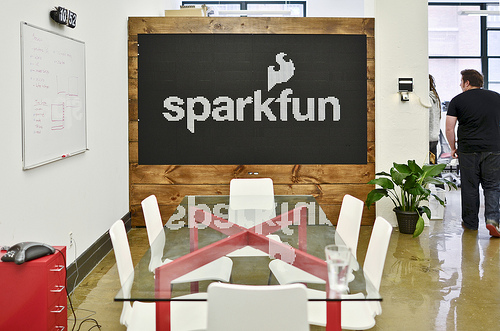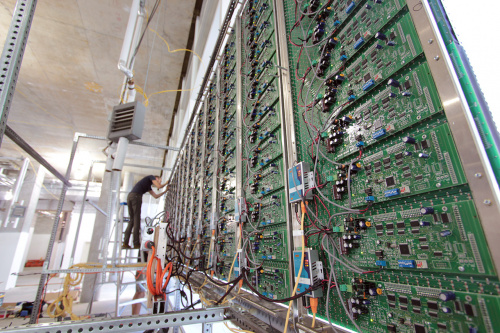A couple months back, a team of SparkFun employees went to New York to meet up with some customers of ours from an outfit called BREAKFAST. BREAKFAST is a marketing firm nestled on the second floor of an old warehouse in Brooklyn. But unlike traditional agencies that focus on things like TV spots, direct mail pieces and the like, BREAKFAST focuses on making promotions an experience - an idea aptly called "experiential marketing." And frankly, they do an outstanding job.
Take for example, their electromagnetic dot display. This was a project designed for the release of TNT's show "Perception." Using hundreds of magnetic flip dots and some clever motion tracking (which is not based on the XBox kinect), they cranked up the flip dots to 15 times their normal operating speed and put a unique advertising installment up in Manhattan. The result is an absolutely stunning visual display. Check out the video to see it in action:
ReplaceMeOpen
ReplaceMeClose
Imagine walking past that thing in person. Would you stop and play around? Of course you would! That's the crux of BREAKFAST's work. They understand that if there were just a billboard or poster about TNT's new show, most people would walk right by. But not this display. It's impossible to ignore.
When we saw this project, we immediately said, "We have to visit these guys!" They gave us a tour of their space, talked shop, and generally inspired us with their ingenuity, passion, and electronics know-how.
The back of the dot display
To read more about our visit with BREAKFAST, check out the page we created here. There you can find some more background on their agency, their co-founder Andrew Zolty, as well as some video of their space and an interview with Zolty himself. Check it out!








Not each personal dot. There are categories of spots that are on the same panel. You can see the common dimension each collection in the last picture of the returning of the range. http://www.lynairlogistics.com.au/contact-us
I bought a number of the bright yellow flip-dots from a surplus store in Toronto (Active Surplus) and immediately had the idea to build a clock. I used 16 modules of 7 dots each to make a digital clock with each digit being 4x7 dots. I ended up using a big noisy array of relays to address the individual dots which made the whole thing sound like an old asr teletype machine when changing the display... Unfortunately the project took me forever to complete and I moved twice... so now most of the modules are damaged an I never actually completed the thing... The modules are very fragile. The problem was mostly the very tiny electromagnets which are wound with 40+awg wire. They tiny wire tends to break off from the coil. Sadly, I don't think Active Surplus has them any more. I would love to get my hands on more modules, but they are impossible to find. I think the ones the had were pulled used from highway signs.
Wow......mind=blown......YET AGAIN only by SparkFun..........
That display is incredible! Sparkfun, do you think you could find and sell electromagnetic displays modules like those used in the video?
We've discussed it more than once; the problem is, finding them at a reasonable price.
If we ever do, you can bet we'll carry them!
I think they ordered them from www.flipdots.com. That site doesn't list any prices for their modules, however. They probably cost a fortune. Delicate products + lower demand than LED boards = $$$$
However Sparkfun does sell small magnets, magnet wire, and relays or power MOSFETs. So that's most of the things you'd need to build your own flip dot displays. The only additional major pieces would be rods or similar pieces of metal for the electromagnet's core and thin, light-weight pieces of material with different colors on each side.
There would also need to be some logic to drive the individual dots and form a display that can communicate with a micro-controller or other control logic. Of course there are probably examples somewhere on the web, so this shouldn't be a serious impediment, even for people lacking the electronics expertise to design it themselves.
As an aside, devising and selling some sort of driver module kit for a small (e.g. 8x8 to 16x16) flip dot array is something Sparkfun could conceivably do on it's own.
Granted, large and densely-packed displays (like those pictured in today's post) would be impractical for most DIYer's. Although more modestly scaled displays would be possible, and likely less expensive.
That... Is amazing!
Does each dot have its own motor?
Its explained here http://www.flipdots.com/how-it-works.html# but basically each dot is the motor.
Not each individual dot. There are groupings of dots that are on the same board. You can see the general size of each grouping in the last photo of the back of the array.
Edit: I realized I wasn't been entirely clear. The link in Chartle's post below explains it in good detail.
Oh I see now. Thanks!
Saw the display a few weeks back on HackaDay.Quite an interesting build.